100 - Tears in Paradise
Thursday, April 24, 2014
New routines have now become normality. The morning bakery walk, round the outside of the village to the stunning views from the horse-trough. Squeezing fresh oranges for breakfast. Driving past the lake down to the coast for coffee and intercambio. A bit of writing. A bit of reading. A tapas or two. Planning an excursion. Pointy-hooded processions and olive-spitting competitions. Walks in the mountains. Catching up with friends in the UK via Facebook.
You become accustomed to what was new and exciting. It stops feeling like a holiday or a fantasy, starts being a way of life. Life in the Axarquía, life in paradise.
Facebook, Skype, emails and WhatsApp. Instant communication. Keeping in touch. Sharing photos, sharing news about the missing cat, the new baby, the ghastly first date, the holiday, the driving test, the dreadful choir rehearsal or the triumphant concert, and the birthday party you missed. It's just like I’m there, with my friends. Most of the time.
Except I’m not. I can't be in two places. I've made a choice. Home is here in Spain. New friends are here in Spain. Old friends are far away. Facebook and Skype keep me in contact, but only up to a point. Which is the real life? And which is just fantasy?
I think I've moved. I feel that this is home now. I think I've stretched the elastic, or even cut the ties. And then suddenly there's a tug. Because actually, there are ties you cannot cut. Elastic stretches but then it pulls back.
Ryanair is great for planned visits, for a round of lunches and sleepovers, gossip and tea, for birthday parties and weddings. But it's no good for unplanned coffee, a laugh or a spontaneous hug. And when you hear the word that can't be spoken, fifteen hundred miles feels just too far. She's braver than I am - she says the word. And it'll all be OK. The scalpel will see to that. It will all be OK. So why am I sitting in paradise with tears running down my face? I couldn't help if I was any nearer. I can't make it go away. I'm useless here, but I couldn't make a difference if I was there.
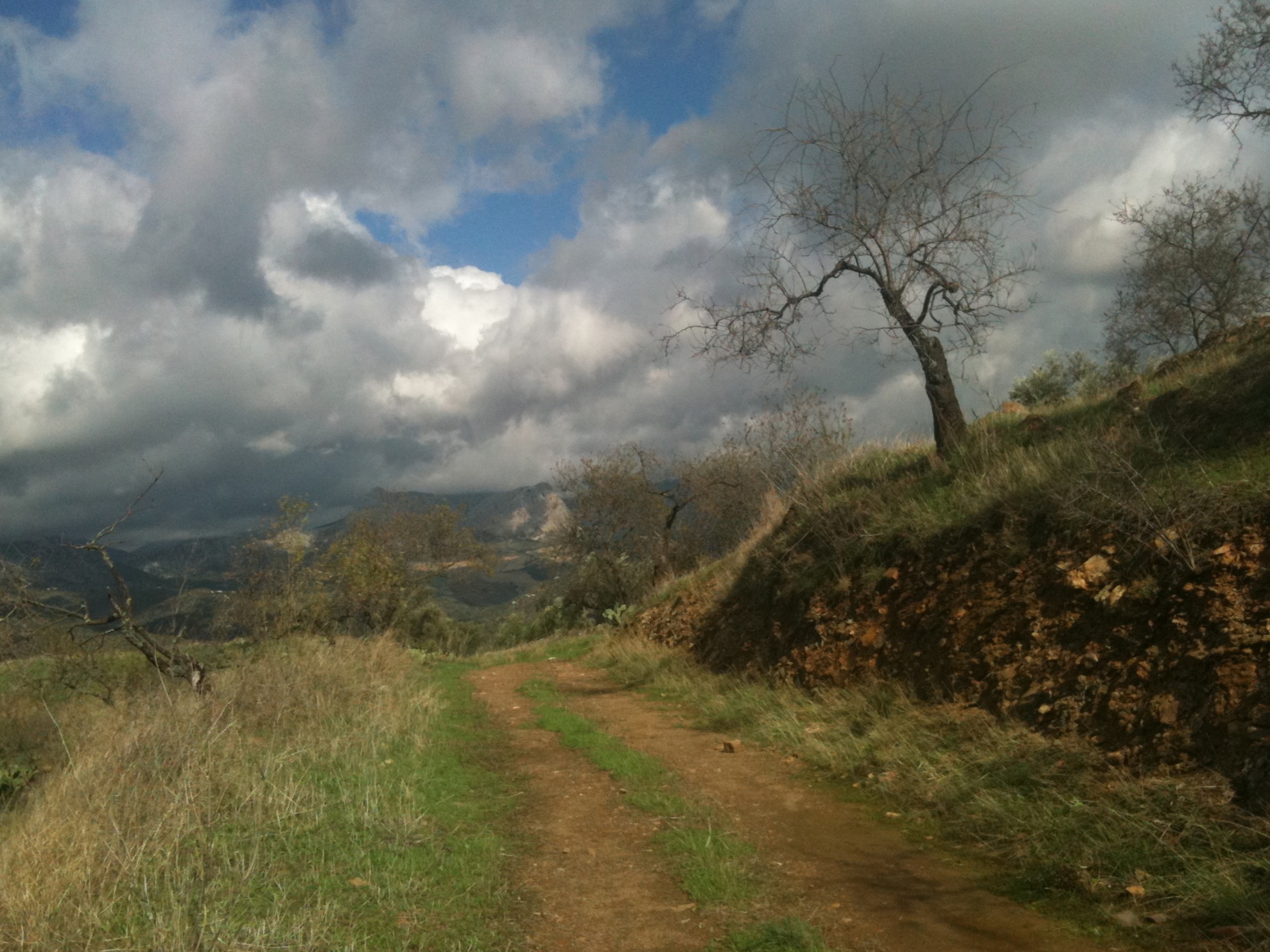 Suddenly this stops feeling like real life. Oranges or avocados straight from the trees, sand between the toes, paella, fiestas, and the Saturday morning seaside photo for Facebook. That's the life I moved here for. None of it has changed, none of it is less than wonderful. It is the paradise I had imagined. Except that because I'm here, I can't be there when all you need is an unplanned coffee, a laugh or a spontaneous hug. I'm sorry. Suddenly this stops feeling like real life. Oranges or avocados straight from the trees, sand between the toes, paella, fiestas, and the Saturday morning seaside photo for Facebook. That's the life I moved here for. None of it has changed, none of it is less than wonderful. It is the paradise I had imagined. Except that because I'm here, I can't be there when all you need is an unplanned coffee, a laugh or a spontaneous hug. I'm sorry.
© Tamara Essex 2014
 0
Like
Published at 9:49 AM Comments (2)
0
Like
Published at 9:49 AM Comments (2)
99 - Wholly About Holy Week (and food and football)
Thursday, April 17, 2014
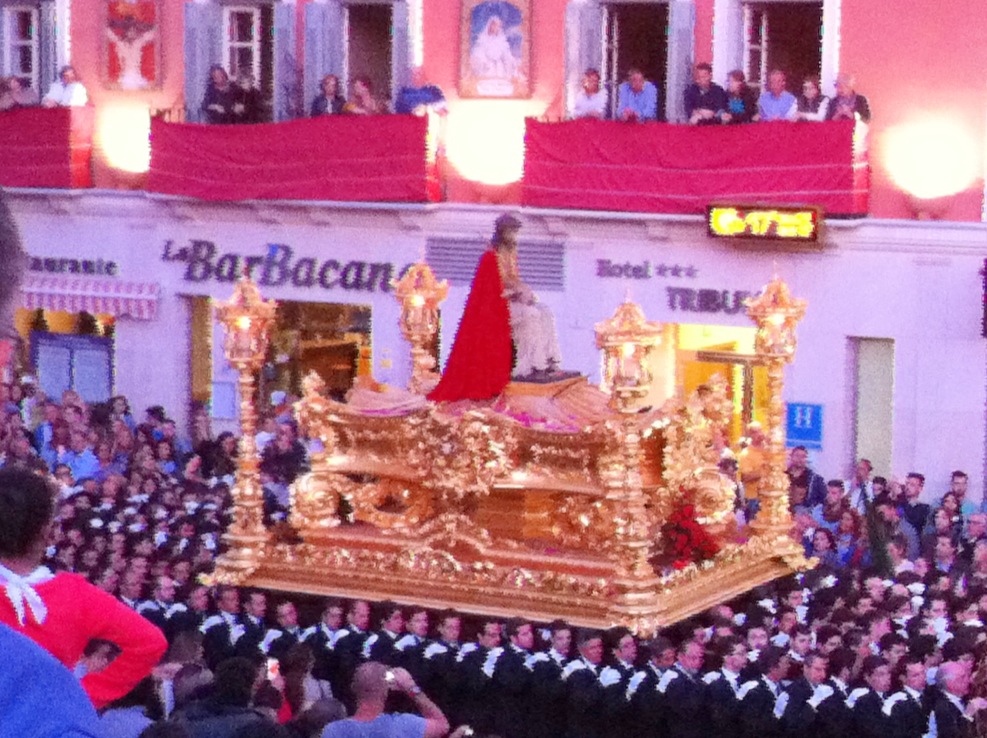 We were trapped at the top of the Tribuna de los Pobres. No chance of moving in any direction. Fortunately we were happy where we were. In front of us, on the bridge, El Cautivo (one of the grandest and most popular Semana Santa floats) had halted, accompanied by 500 Nazarenos in their tall hoods. Below us at the foot of the curved steps crowded with people, the beautiful float of Los Estudiantes moved slowly and majestically by. We were trapped at the top of the Tribuna de los Pobres. No chance of moving in any direction. Fortunately we were happy where we were. In front of us, on the bridge, El Cautivo (one of the grandest and most popular Semana Santa floats) had halted, accompanied by 500 Nazarenos in their tall hoods. Below us at the foot of the curved steps crowded with people, the beautiful float of Los Estudiantes moved slowly and majestically by.
"Spain is Different". So their advertising slogan went some years ago. And never is it more true than in Semana Santa. This year was even better for me, because with a bit more knowledge I understood more and was in the right places at the right times.
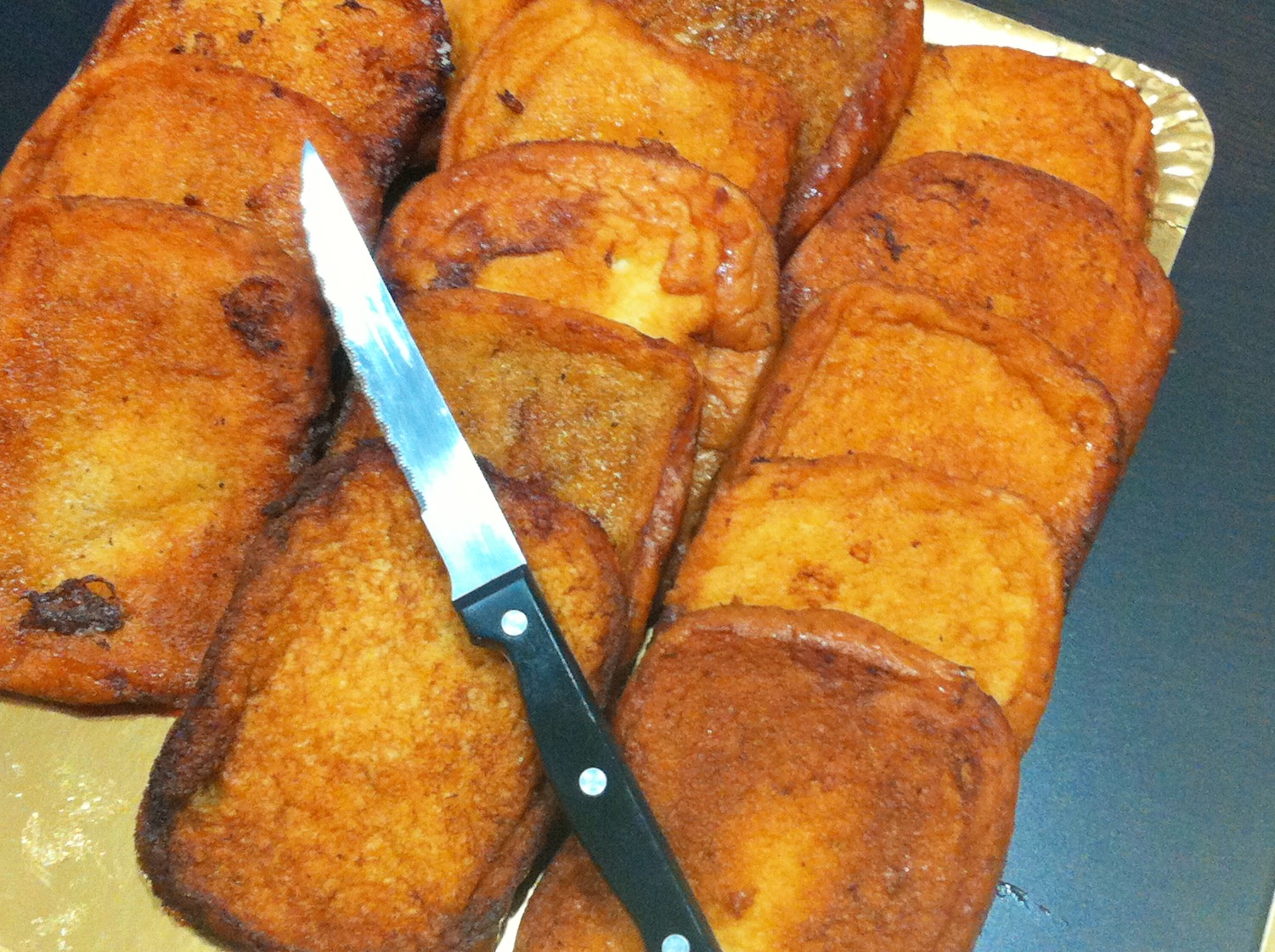 It had begun with food. Always a good start! The week before, Axalingua language school had organised a cultural class to learn more about Semana Santa, and it included coffee and delicious torrijas made by Juanmi's mum. These were a sort of eggy-bread with olive oil and cinnamon. While we munched, Juanmi explained all the different parts which make up each procession. Organised by the many cofradías (brotherhoods) in Málaga, each procession is headed by la cruz guia (the guide carrying the cross), then the guardería (the children of the members of the cofradía in their little costumes). Behind them come the Nazarenos (in their white or coloured cloaks and the capirotes or pointy hoods which symbolise Semana Santa in southern Spain), followed by the band. It had begun with food. Always a good start! The week before, Axalingua language school had organised a cultural class to learn more about Semana Santa, and it included coffee and delicious torrijas made by Juanmi's mum. These were a sort of eggy-bread with olive oil and cinnamon. While we munched, Juanmi explained all the different parts which make up each procession. Organised by the many cofradías (brotherhoods) in Málaga, each procession is headed by la cruz guia (the guide carrying the cross), then the guardería (the children of the members of the cofradía in their little costumes). Behind them come the Nazarenos (in their white or coloured cloaks and the capirotes or pointy hoods which symbolise Semana Santa in southern Spain), followed by the band.
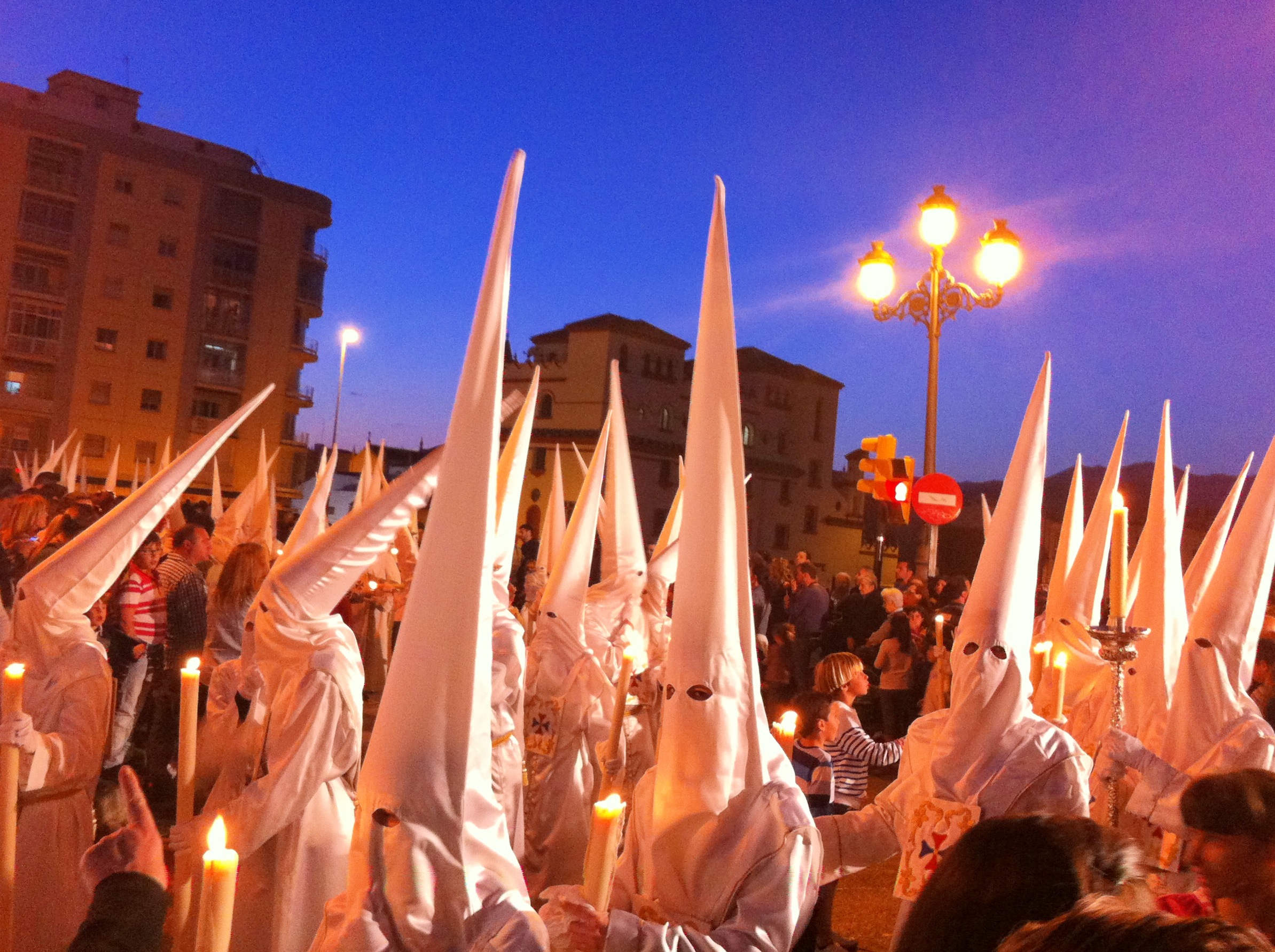 Finally comes the trono (the throne, or float) carrying the image of Jesus. Depending on its size, the float is carried by anything from 120 to 500 hombres de trono (in Málaga women are still not permitted to join the throne-bearers). More hooded Nazarenos, all members of the cofradía, accompany and follow the throne, and at the rear are the penitentes - members of the public (dressed in ordinary clothes) following devotedly, often with candles. In many processions the whole thing is repeated for the second throne, that of the Virgin. Finally comes the trono (the throne, or float) carrying the image of Jesus. Depending on its size, the float is carried by anything from 120 to 500 hombres de trono (in Málaga women are still not permitted to join the throne-bearers). More hooded Nazarenos, all members of the cofradía, accompany and follow the throne, and at the rear are the penitentes - members of the public (dressed in ordinary clothes) following devotedly, often with candles. In many processions the whole thing is repeated for the second throne, that of the Virgin.
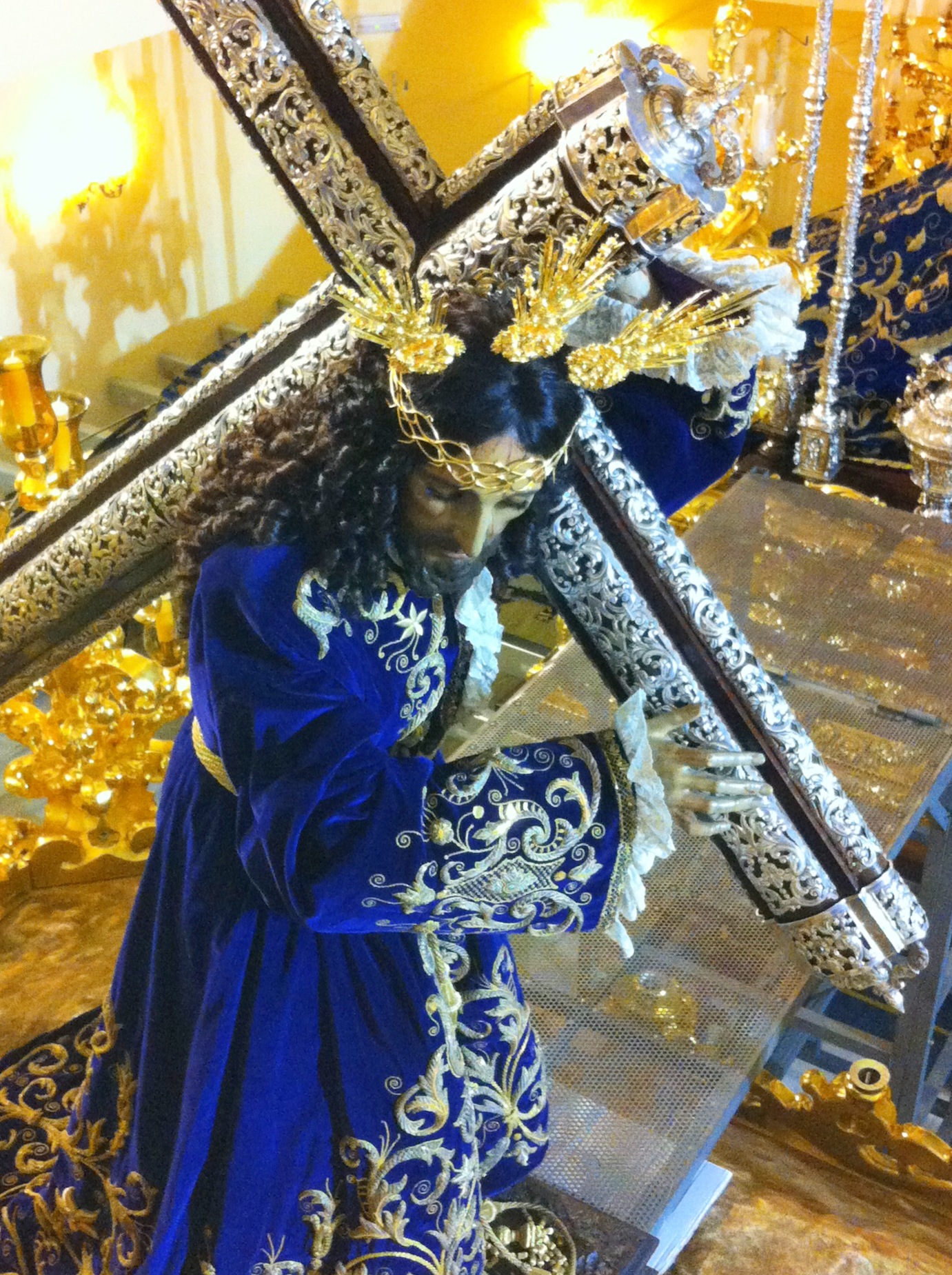 The following day Juanmi led us around Málaga, through some of the cofradías and into churches to see los imagenes (the statues of Christ and the Virgin which mostly remain in their local churches, until they transfer a few days before Semana Santa to the cofradía's base where the thrones are stored, to be prepared for the procession). We even had a private visit into La Casa Hermandad de Jesús el Rico. The following day Juanmi led us around Málaga, through some of the cofradías and into churches to see los imagenes (the statues of Christ and the Virgin which mostly remain in their local churches, until they transfer a few days before Semana Santa to the cofradía's base where the thrones are stored, to be prepared for the procession). We even had a private visit into La Casa Hermandad de Jesús el Rico.
In a restaurant for lunch after the visit, there were a few Semana Santa themed menu items. I went for Torrija de Pan Brioche con Crema de Lima y Helado de Yema Tostada. Don't tell Juanmi, but these torrijas with rich lime cream and toasted egg-yolk ice-cream were EVEN more delicious than his mum's!
In my village of Colmenar, Semana Santa kicked off with the traslado, the transfer of the statue of Christ from the church to the cofradia's base, on Saturday night. It is a very serious part of the rituals, but it is before Semana Santa so the hombres de trono are not wearing the formal costumes which will be seen on Viernes Santo for the village procession.
So into Málaga for Lunes Santo, holy Monday, one of the most popular evenings for Málagueños as the city's favourite trono of El Cautivo goes by. With 240 hombres de trono to carry it, and 500 Nazarenos, this is among the most spectacular events of the week. And this year, either by good planning or just good luck, we were by the Puente Aurora at the top of the Tribuna de los Pobres to get a perfect view. The Tribuna de los Pobres is the "poor people's stand" - tickets for seats in the official Tribunas in Calle Larios or Alameda Principal are hard to get and cost over €150 (though that is for the whole week), but by Puerta Nueva the big fan-shaped steps offer the perfect free viewing point.
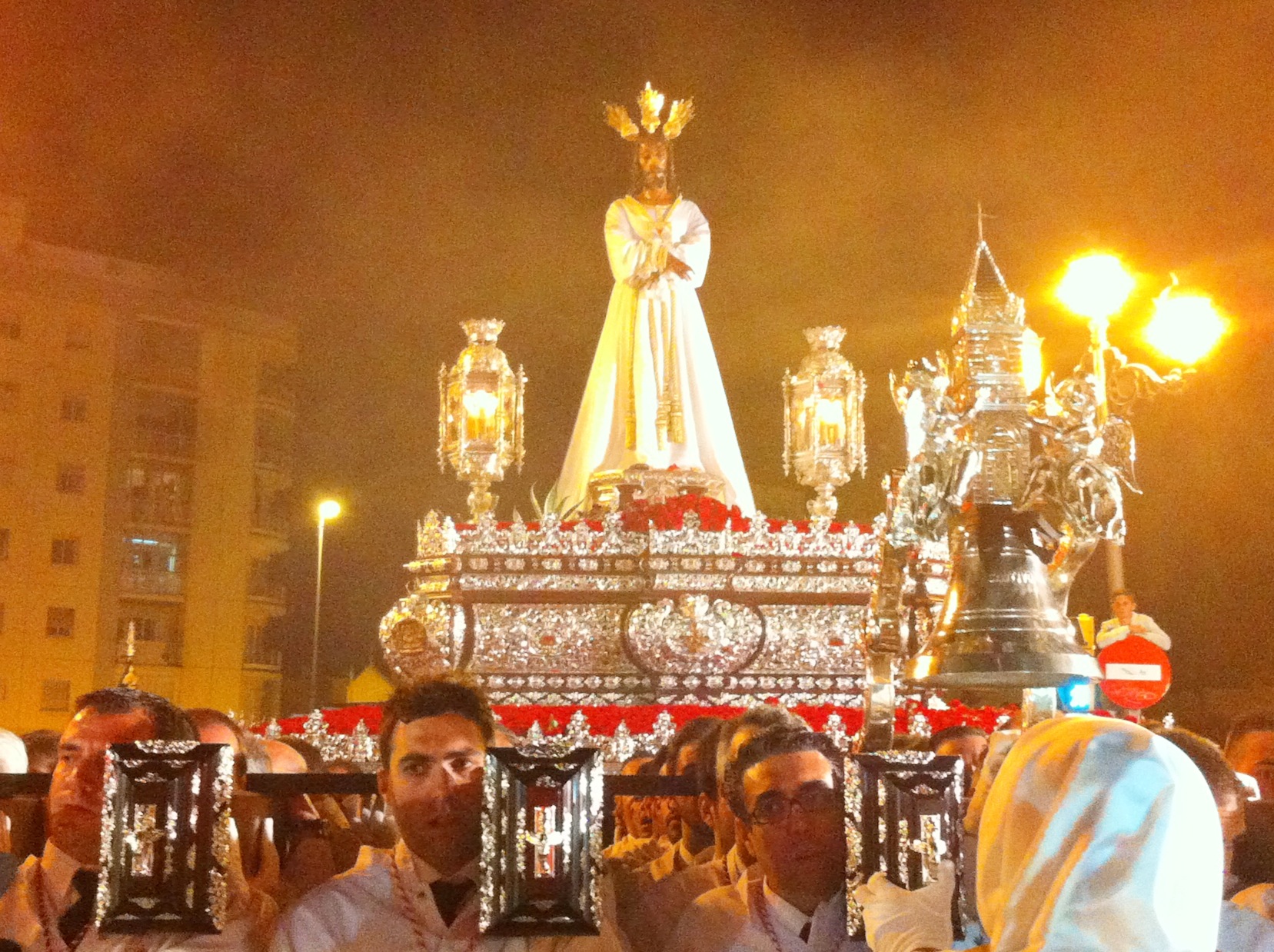 Below us at the foot of the steps Los Estudiantes carried their grand gold trono with a red-caped thorn-crowned Jesus (Santisimo Cristo Coronado de Espines) while in front of us on the bridge El Cautivo waited patiently, avoiding a clash of trumpets and drums. Once the competition was out of the way, El Cautivo continued, the hombres de trono probably glad of the rest. As the enormous trono turned the corner, people were pushed back against the wall to avoid the heavy swaying float. Behind it, the press of penitentes was huge and needed a phalanx of cofradía officials to control them. Below us at the foot of the steps Los Estudiantes carried their grand gold trono with a red-caped thorn-crowned Jesus (Santisimo Cristo Coronado de Espines) while in front of us on the bridge El Cautivo waited patiently, avoiding a clash of trumpets and drums. Once the competition was out of the way, El Cautivo continued, the hombres de trono probably glad of the rest. As the enormous trono turned the corner, people were pushed back against the wall to avoid the heavy swaying float. Behind it, the press of penitentes was huge and needed a phalanx of cofradía officials to control them.
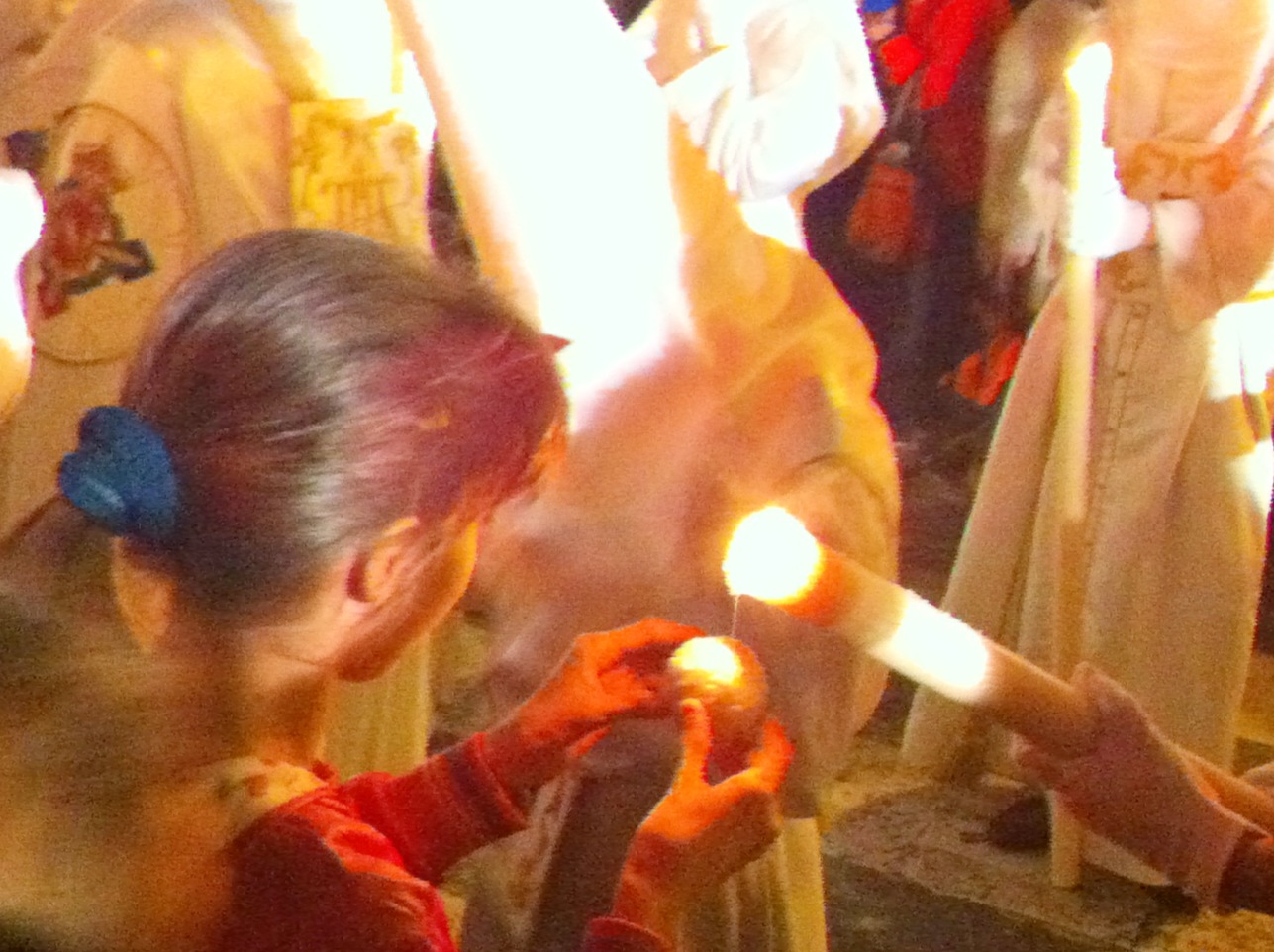 Children pushed forward and pleaded with the Nazarenos to drip their candles onto the balls of wax they will build up throughout the week. Above, on a residential balcony, a singer broke out into a saeta, a religious song. The crowd shushed each other to listen, and at the end he received well-deserved applause from the procession as well as the crowd. Children pushed forward and pleaded with the Nazarenos to drip their candles onto the balls of wax they will build up throughout the week. Above, on a residential balcony, a singer broke out into a saeta, a religious song. The crowd shushed each other to listen, and at the end he received well-deserved applause from the procession as well as the crowd.
On Wednesday there seemed to be a Jesus on every corner. Thirteen tronos fighting for space. There were great views again from La Tribuna de los Pobres, contrasting with the formality of the ticket-only Tribunas in Calle Larios and La Plaza de la Constitución. An 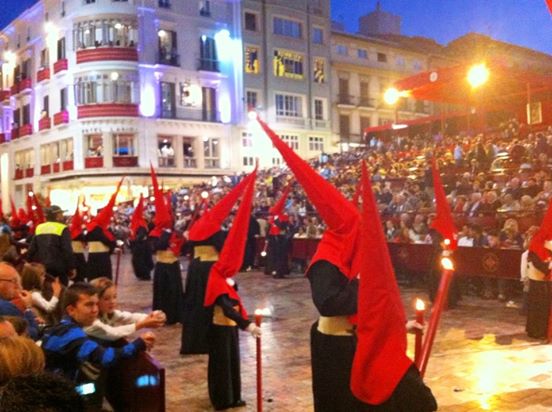 unfortunate clash of programming meant that bars just off Calle Larios were showing La Copa del Rey football match between Barcelona and Real Madrid, and even people in the tribunas had mobile phones clasped to their ears to listen to the commentary. Each roar from the bars was followed by whispers through the crowd – “Madrid scored first …” … “Now Barça have equalised …” … until finally Gareth Bale won it for Real Madrid just before close of play. A strange coming together of cultures, perhaps Spain’s two great guiding forces, football and the church, clashing in Calle Larios as half those present stood to pay their respects to La Virgen while the other half shouted with delight or despair at their teams. unfortunate clash of programming meant that bars just off Calle Larios were showing La Copa del Rey football match between Barcelona and Real Madrid, and even people in the tribunas had mobile phones clasped to their ears to listen to the commentary. Each roar from the bars was followed by whispers through the crowd – “Madrid scored first …” … “Now Barça have equalised …” … until finally Gareth Bale won it for Real Madrid just before close of play. A strange coming together of cultures, perhaps Spain’s two great guiding forces, football and the church, clashing in Calle Larios as half those present stood to pay their respects to La Virgen while the other half shouted with delight or despair at their teams.
And as always, the event was hugely emotional. You don't need to have one iota of religion in you to be moved by Spain's Semana Santa. You can marvel at the riches of the churches and the cofradías, you can wonder for a moment whether the money could have been spent more usefully, and you can watch bemused as penitentes and  members of the watching crowds sob and even fall on the ground as their beloved statues pass by. But you cannot ignore Semana Santa, and you cannot fail to be impressed by the organisation, the devotion, the sense of community (and not only in the cofradías but amongst the crowds as well). "Spain is Different"? Oh yes. And Semana Santa is special, for those with faith and for those without who just like a good party. members of the watching crowds sob and even fall on the ground as their beloved statues pass by. But you cannot ignore Semana Santa, and you cannot fail to be impressed by the organisation, the devotion, the sense of community (and not only in the cofradías but amongst the crowds as well). "Spain is Different"? Oh yes. And Semana Santa is special, for those with faith and for those without who just like a good party.
Now, anybody fancy a chocolate-covered Nazareno?
NB - For a slightly more reverent take on Semana Santa, see my post last year "The Splendour and the Silence".
© Tamara Essex 2014
THIS WEEK’S LANGUAGE POINT
Odd isn’t it, how sometimes something just doesn’t mean the same thing in a foreign language? One of the things I am often asked as an extranjera is how long I have lived in Spain. If I were to answer in English, I would of course say “I have lived here for almost two years.” So, having learned my present perfect tense, I respond in Spanish “He vivido aqui casi dos años.”
But that’s wrong. In Spanish that implies I have lived here before but I don’t any more. For example it WOULD be correct to answer the question “Have you ever been to Australia?” with the reply “Si, he vivido allí tres años” – yes, I have lived there for three years. But I don’t now.
Because the present perfect is, in fact, a past tense. He comido la manzana – I have eaten the apple, and I have finished eating the apple – the apple is no more. He aparcado el coche – I have parked the car. I am not parking it now, it is parked and now I am here in a bar with you telling you I have parked it.
OK that sort of makes sense. Certainly “I have lived here” is the only time I would try to use that tense for something that is still happening, so it figures that it is wrong. The truth is that it is the English that is wrong!
So the correct reply to “How long have you lived here?” needs to be –
“Llevo viviendo aqui casi dos años.” or “Vivo aquí desde hace casi dos años.”
(PS – a reader has suggested that I paste all the language points into one document, and publish that as a “pinned post” in the blog header. That sounds like a good idea, as I have occasionally wanted to find a particular language point but had no idea which blog it was in. So this will happen shortly.)
 0
Like
Published at 2:15 PM Comments (0)
0
Like
Published at 2:15 PM Comments (0)
98 - Foreign Food
Friday, April 11, 2014
So I asked her in my best Spanish “Donde se puede encontrar latas de la leche de coco, para cocinar?” Where can one find tins of coconut milk for cooking? She looked up from her shelf-stacking and sighed. She jerked her head over towards the next aisle. “Estan por allí” she said. They’re over there. “En las estanterías para …” (at this point I’d swear her lip curled slightly) … “… para comidas extranjeras.” On the shelf for, well, foreign food.
It was an aisle I hadn’t entered before. There were tins of Heinz baked beans, bottles of salad cream, and English breakfast teabags. There was Weetabix, and Marmite, and some Newcastle Brown Ale. Further along were Pot Noodles, soy sauce, jars of Rogan Josh curry sauce, and twenty tins of coconut milk. I took four.
I’d already tried all the shops in Colmenar and drawn a blank. I’d tried Mercadona in Torre del Mar with no luck. The kitchen at the Tanit restaurant showed me a tin and said it was bought locally but they didn’t know where. My last chance was Eroski at El Ingenio shopping centre between Torre del Mar and Velez-Málaga. Where I was sighed and sneered at.
Fortunately the woman at the till was much friendlier. She gasped slightly when my four tins came to almost ten euros. “Es muy caro, no?” she asked. “Si, pero es muy importante para la receta,” I replied – yes it’s expensive, but I needed it for the recipe. “Ah, no es para beber?” she asked, isn’t it for drinking? “No, es para cocinar. Es para un curry, pero un curry de Tailandia, no de la India. Es un sabor muy fresco, muy ligero – delicioso!” A light, fresh taste, for cooking Thai curry. She quizzed me on the recipe and promised to try it.
So why did the first woman sneer at my question? I have no doubt my accent was rubbish but I did ask in Spanish. And I wasn’t asking for something which has a perfectly acceptable Spanish equivalent. Ah well, maybe she was having a bad day, or had been asked too many times for the English section, who knows? A notable encounter only because it was so rare.
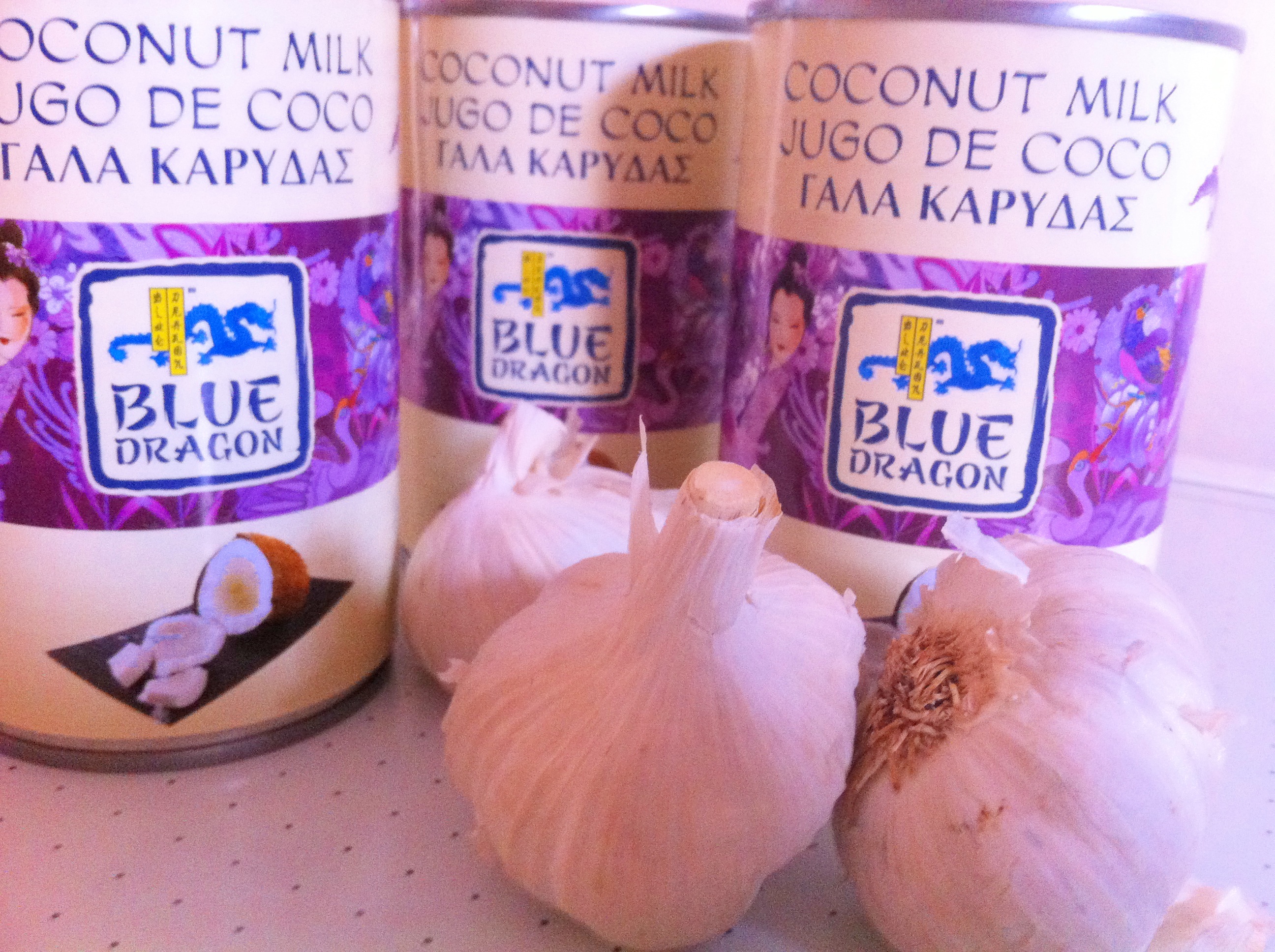 Back at home three cans went on the shelf and one into the pot. Prawns fried in garlic, then fresh tomatoes and a big dollop of Thai green curry paste, add some spinach then the coconut milk. Cook up the rice, serve, and graciously accept the compliments (and from a chef, no less!). A recipe for success. Back at home three cans went on the shelf and one into the pot. Prawns fried in garlic, then fresh tomatoes and a big dollop of Thai green curry paste, add some spinach then the coconut milk. Cook up the rice, serve, and graciously accept the compliments (and from a chef, no less!). A recipe for success.
© Tamara Essex 2014
THIS WEEK’S LANGUAGE POINT:
Oh we are struggling. Some of us to the point of refusing ever to use the subjunctive! But we had a breakthrough this week. We’re still trying to make hypotheses, and we struggle with the degrees of uncertainty that trigger the subjunctive rather than the indicative. Juanmi has done his best, jumping from the left (definitely yes) to the right (definitely no) and then hovering in the middle, the uncertain area, where the subjunctive is used.
The problem has been that our text book says that we use “Probablemente …” with the indicative, but “Es probable que ….” with the subjunctive. Whereas to us the degree of uncertainty seems the same. But this morning a lightbulb came on (or went off – our language is confusing too!). The “que” of course triggers the subjunctive. OK, but why does “Posiblemente …” use the indicative? It generally implies a fair degree of doubt. It’s all in the tone, says Juanmi.
But then he looked sheepish and went to get another textbook. The truth finally emerged. Our textbook lists a hard and fast rule that after “Posiblemente …” you use the indicative. But this OTHER textbook says you can use the indicative OR the subjunctive after “posiblemente”!!! So it depends on our own perception of the degree of doubt, rather than being a hard and fast rule! Phew. Suddenly it all seemed a bit more manageable. A bit more possible. Por lo menos, posiblemente.
“Posiblemente, vaya a usar el subjuntivo ésta semana.”
 0
Like
Published at 8:59 AM Comments (5)
0
Like
Published at 8:59 AM Comments (5)
97 - "Tomorrow, Tamara, to Maro!"
Thursday, April 3, 2014
So, two days before packing my rucksack, John posted a picture on Facebook. Well, not a picture, a route-map. The map of the GR242 50-mile walk I'd signed up for. With a profile chart of the height gained each day. Uh-oh.
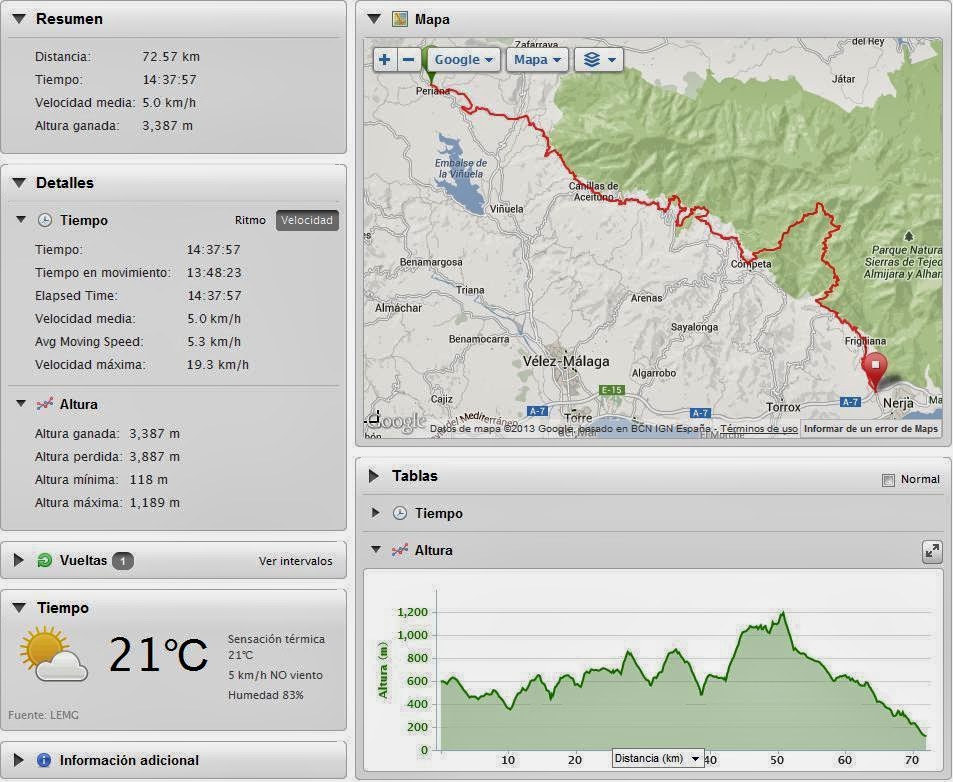 It was his 50th birthday, and he'd invited a whole bunch of us to donate €50 to Cudeca (the local cancer support charity) and walk 50 miles with him to celebrate (yeah, I know - whatever happened to a few drinks down the bar?). 50 miles "downwards" from Periana, high up above the Viñuela reservoir near the Zafarraya Pass, gradually dropping down to Maro, just above the sea at Nerja. It was his 50th birthday, and he'd invited a whole bunch of us to donate €50 to Cudeca (the local cancer support charity) and walk 50 miles with him to celebrate (yeah, I know - whatever happened to a few drinks down the bar?). 50 miles "downwards" from Periana, high up above the Viñuela reservoir near the Zafarraya Pass, gradually dropping down to Maro, just above the sea at Nerja.
Except "downward" didn't really tell the whole story. Yes, you can start at 1250 metres altitude and end up at sea-level, but that doesn't mean it's a downhill stroll. No indeed. The map arrived, and the altitude profile chart. It had a lot of pointy-uppy bits. A knot of worry settled into my stomach.
The day dawned. Sandwich in rucksack, boots and t-shirts packed, I drove to the finish-line at Nerja and parked near the bus station. Our special bus was ready and by 10am we decanted at Periana and The Long Walk began.
There is something very romantic about the sound of the GR routes. "Gran Ruta" or "Gran Recorrida" in Spanish, "Grand Route" in English and French. They criss-cross Europe and have standardised wooden posts with red and white rings to mark the way. The Tour de Mont Blanc is one. I did that one, but more than a couple of decades ago. When I was young. And fit. And thin(ner). This is a GR as well, though admittedly not quite in the same league.
Beautiful March weather. We can see the sea twinkling ahead of us. A mere 50 miles separates us from our goal. Oh and the little matter of over 3,000 metres of climbing. Hmmm. METRES.
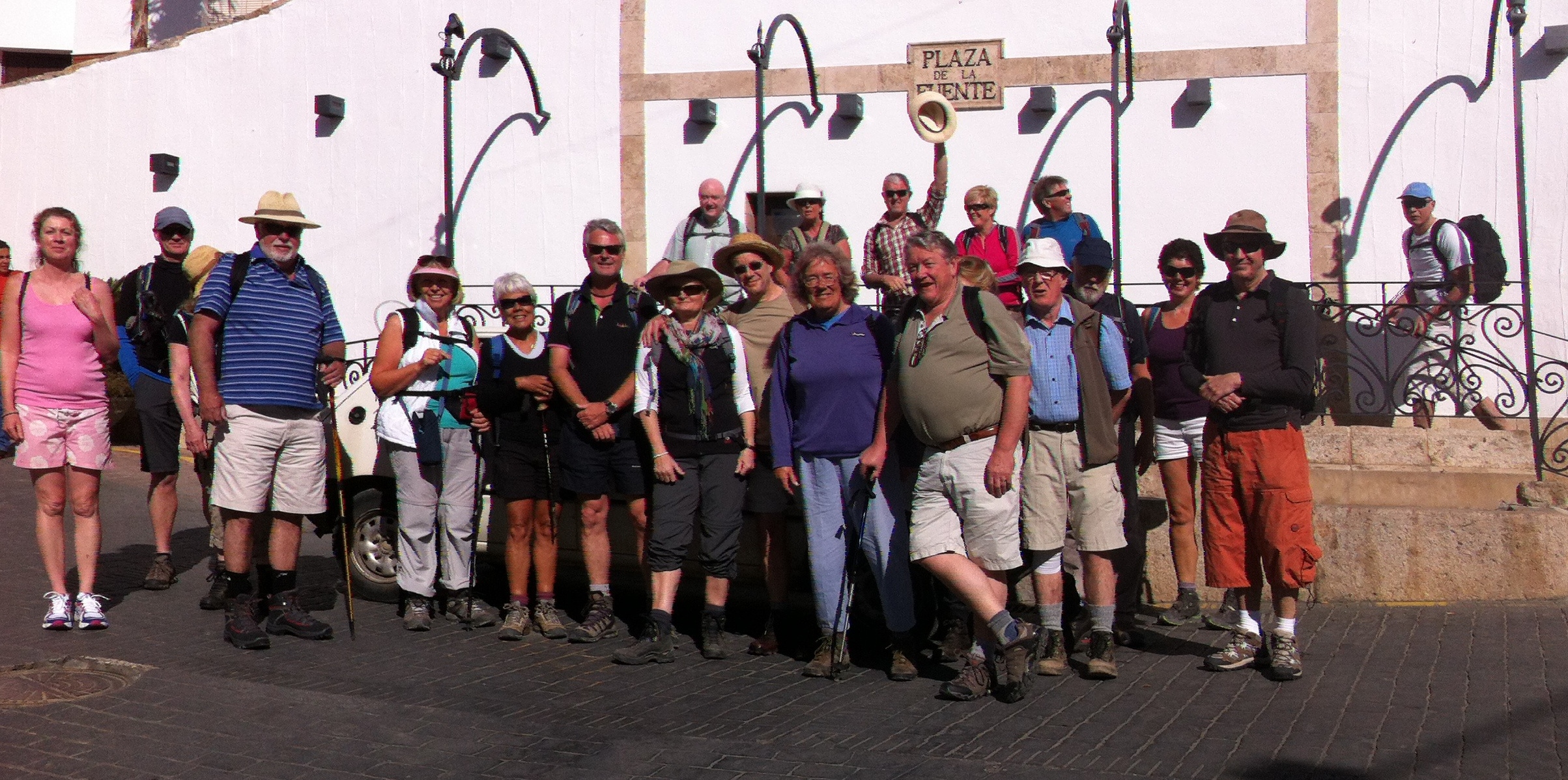 We started in my patch. New to everyone else, we were up above the east side of Viñuela reservoir the whole day, and for most of the day we could see Colmenar! The morning broke us in nicely, being mostly a decent track from Periana (where the official start photo was taken) to Alcaucín where a row of wall fountains proved to be a magnet after the hot morning. The young man in Bar Enrique wasn't wholly prepared for the sudden arrival of 30 thirsty walkers, but raised no objection to the annexing of his terrace to eat our sandwiches. We started in my patch. New to everyone else, we were up above the east side of Viñuela reservoir the whole day, and for most of the day we could see Colmenar! The morning broke us in nicely, being mostly a decent track from Periana (where the official start photo was taken) to Alcaucín where a row of wall fountains proved to be a magnet after the hot morning. The young man in Bar Enrique wasn't wholly prepared for the sudden arrival of 30 thirsty walkers, but raised no objection to the annexing of his terrace to eat our sandwiches.
.jpg) "We've done two thirds" said John confidently. And so began four days of Irish-isms. Because he didn't say "thirds" he said "turds". And we were to hear daily from John and the number of successfully completed turds .... "We've done two thirds" said John confidently. And so began four days of Irish-isms. Because he didn't say "thirds" he said "turds". And we were to hear daily from John and the number of successfully completed turds ....
The finger-post leading us out of Alcaucin towards Canillas de Aceituno said 6.6 kilometres more. The track petered out and delved into a cool pine forest, then plunged down into a deep ravine, leaving us scrambling up the other side. Up at the front, Tracey and I briefly became accidental leaders, our slightly sceptical followers only cheering up when Tracey called out with delight on finding another official way-post. The final climb of day one felt longer than it was, and the sight of Bar La Maroma was a welcome one. Especially for Joan, whose plea to a passing truck for a lift to the village (just 500 metres away but the hard road was gruelling underfoot) almost had her whisked 40 miles away to Velez-Málaga as the kindly driver mistook her soft Irish pronunciation of "village" to be "Velez".
Beers, coffees and juices all round, then Paco led us round the village dividing us amongst three houses. He had fixed for us to have dinner, bed, breakfast AND a packed lunch for just €40 a head. Fine rural hospitality.
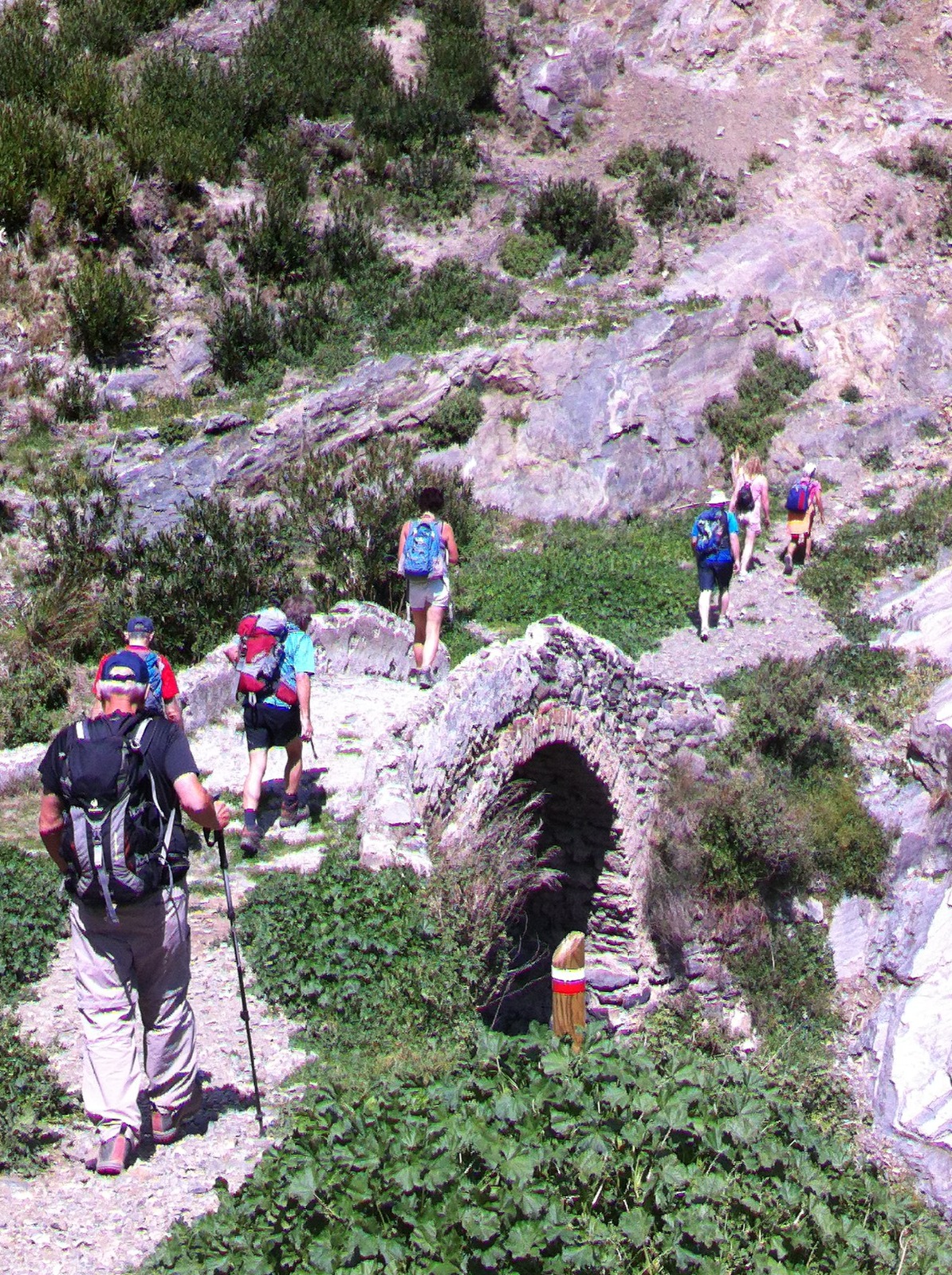 Day two dawned and it wasn't only me that looked longingly at the car that was taking our bags to the next overnight stop. In Sedella we piled into Maria's bar before descending further to the well-preserved Roman bridge. Under the baking sun I thanked for the umpteenth time my distant ancestors on my father's side who put a Sicilian gene somewhere in my make-up, ensuring that I go a decent olivey-brown without burning. Day two dawned and it wasn't only me that looked longingly at the car that was taking our bags to the next overnight stop. In Sedella we piled into Maria's bar before descending further to the well-preserved Roman bridge. Under the baking sun I thanked for the umpteenth time my distant ancestors on my father's side who put a Sicilian gene somewhere in my make-up, ensuring that I go a decent olivey-brown without burning.
On to the pretty aldea (somewhere between a hamlet and a small village) of Salares, then to Canillas de Albaida, and finally to a deep, warm bath at Cómpeta's Hotel Balcón. I tried to encourage a few people to walk a couple of hundred metres to visit the pretty plaza and El Paseo de las Tradiciones but was ignored as people tended to blisters, pink shoulders, and an irresistible desire for a cold beer on the terrace.
At dinner, balloons and a cake marked John's 50th but there were no late-night celebrations as we all knew the hardest day was the next. Though perhaps at this point it is worth pointing out that about 50% of the group was Irish, so the evening was not complete without a degree of midnight singing. It was his birthday after all, so it was.
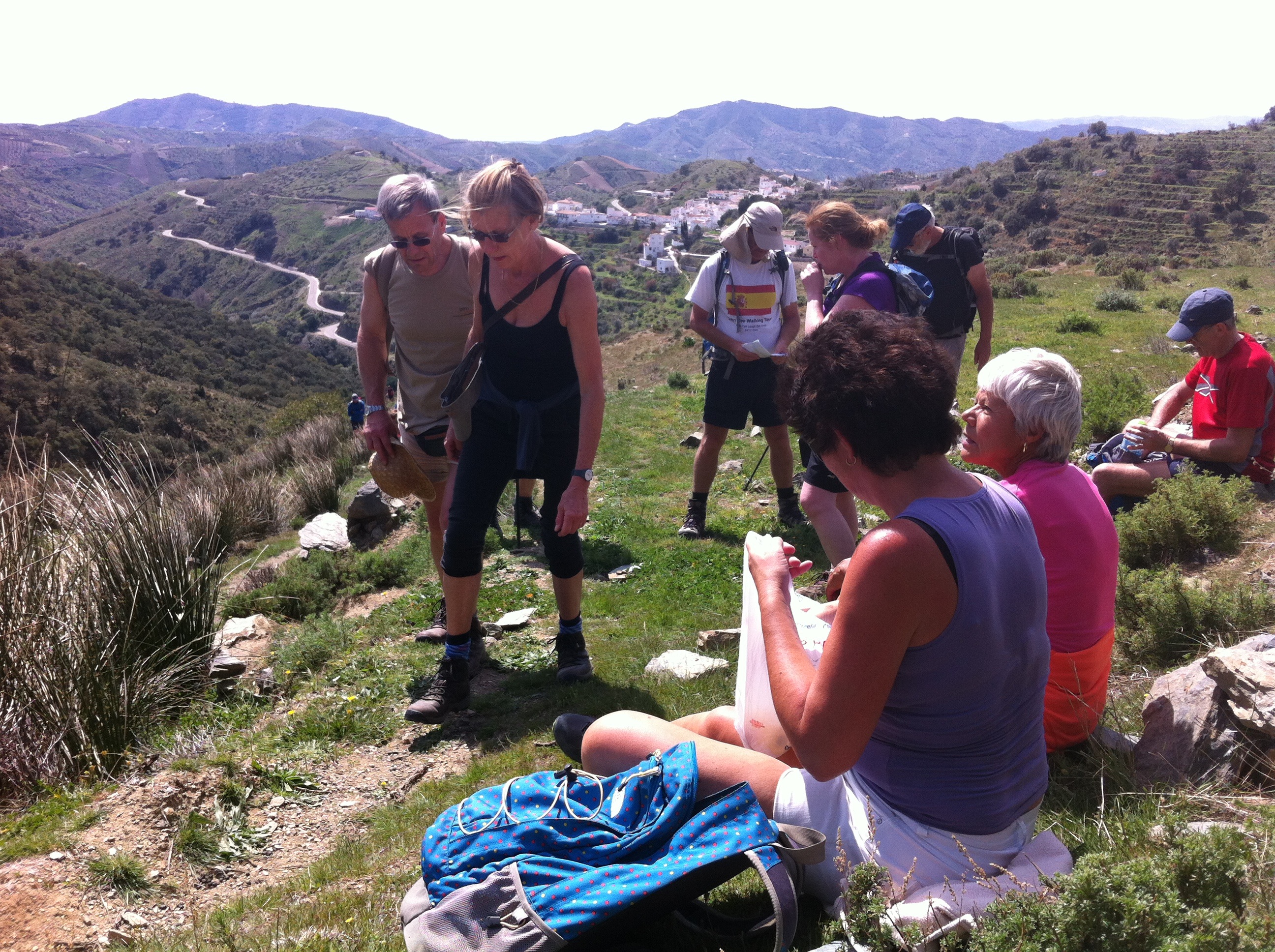 Day three was the main reason I had signed up for this. We were walking to the hidden village of El Acebuchál - something I had longed to do since reading about it 18 months ago. The group split into two. The "hard-core" taking the high road and about one "turd" taking the low road. John handed me the second radio, we exchanged mobile numbers for back-up, and we went our separate ways. Our group (the low route, in case anyone was wondering!), reached the planned meeting point early, having had a beautiful but flattish walk. As agreed, I radioed to John to confirm our position and tell him we would carry on. The radios had approximately 2km range, but we hadn't accounted for the massive great mountain between us and the other two "turds". I kept trying, occasionally receiving an incomprehensible crackle back. And then the batteries died. No phone signal either, of course. I pulled an empty peach juice carton from my rucksack, the fantastically well-equipped Jane produced a length of wool from hers and we tied it to the fingerpost at the path junction with a note saying we were heading for El Acebuchál. Day three was the main reason I had signed up for this. We were walking to the hidden village of El Acebuchál - something I had longed to do since reading about it 18 months ago. The group split into two. The "hard-core" taking the high road and about one "turd" taking the low road. John handed me the second radio, we exchanged mobile numbers for back-up, and we went our separate ways. Our group (the low route, in case anyone was wondering!), reached the planned meeting point early, having had a beautiful but flattish walk. As agreed, I radioed to John to confirm our position and tell him we would carry on. The radios had approximately 2km range, but we hadn't accounted for the massive great mountain between us and the other two "turds". I kept trying, occasionally receiving an incomprehensible crackle back. And then the batteries died. No phone signal either, of course. I pulled an empty peach juice carton from my rucksack, the fantastically well-equipped Jane produced a length of wool from hers and we tied it to the fingerpost at the path junction with a note saying we were heading for El Acebuchál.
Contouring round the headland later, we looked back and saw the group on the track, probably about 40 minutes behind us. Mad waving across the ravine, and with communication restored the sight of the others for some unaccountable reason put a spring in our step (competitive, moi?) and we strode on, waking up the wasps in their nest ahead of the main group (!), until finally we turned down into the dry river bed for the final march into El Acebuchál.
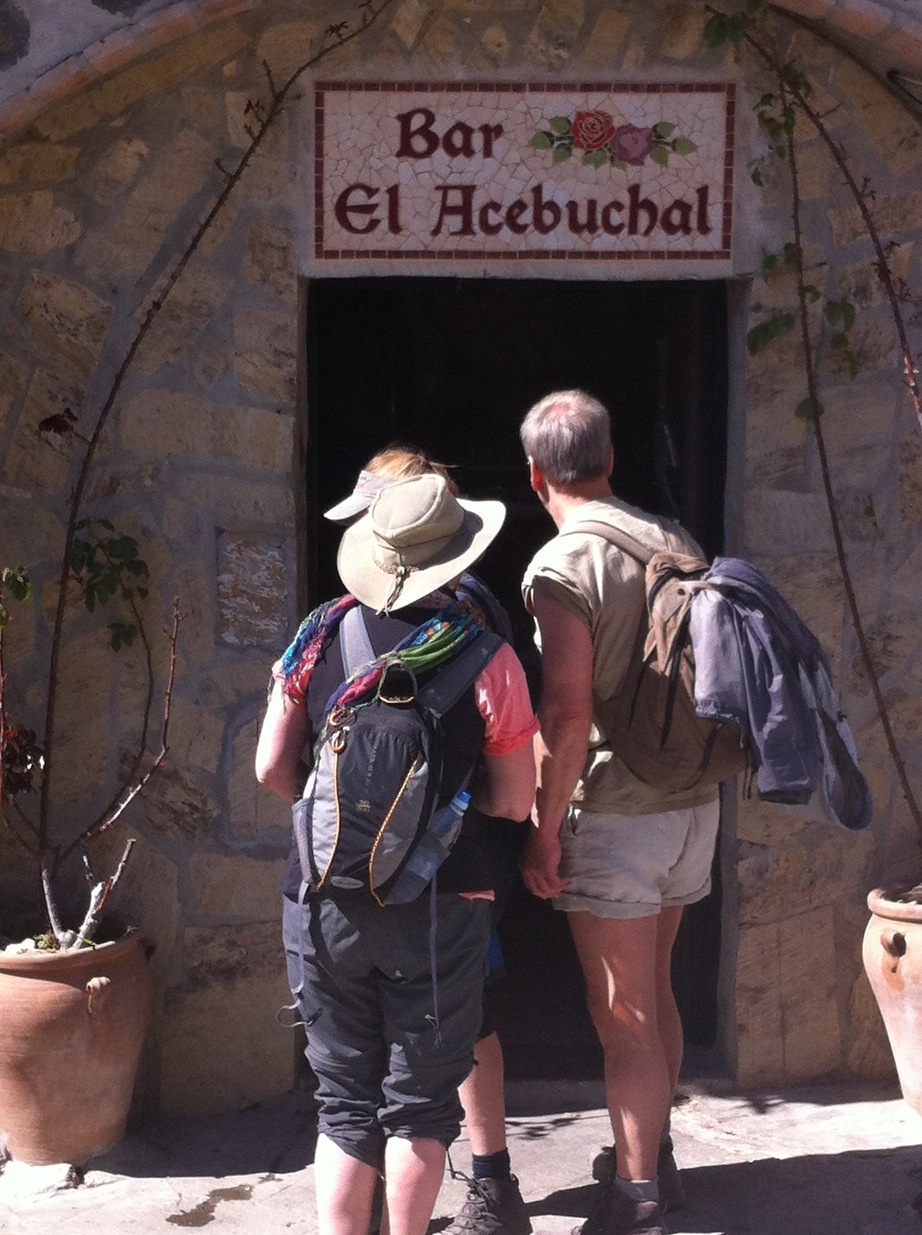 For me it was a disproportionately emotional moment. I had no aims from this Gran Ruta other than to enjoy myself and stretch the leg muscles. I didn't mind if I didn't complete the whole thing. But I DID want to walk into El Acebuchál, and I had done it. We colonised the bar, warmly welcomed by Antonio and his family, got in a round of the famous Acebuchál cakes, and just 15 minutes later we welcomed the high-level walkers with a round of applause for their achievement. For me it was a disproportionately emotional moment. I had no aims from this Gran Ruta other than to enjoy myself and stretch the leg muscles. I didn't mind if I didn't complete the whole thing. But I DID want to walk into El Acebuchál, and I had done it. We colonised the bar, warmly welcomed by Antonio and his family, got in a round of the famous Acebuchál cakes, and just 15 minutes later we welcomed the high-level walkers with a round of applause for their achievement.
After his first drink (or three) I thought I'd better return the now-useless radio to John. He packed it away then looked up with a twinkle. "Tamara", he said, "I need to say this to you". A mischievous grin and then he said "Tomorrow, Tamara, to Maro!" He'd been working on that one all day. To be fair, it is the first NEW joke I'd heard about my name in over 30 years! And, to be fair, it was a cracker (so it was).
After settling into the sweet little cottages around the village we returned to the bar terrace for our final evening meal together. And what a meal! Roasted peppers followed by home-baked bread and oil, a massive salad, then chicken, pobre patatas, then jabalí (wild boar), rice, coconut curried pork, wine, cake, and coffee. More great rural hospitality. All around me there were satisfied murmurings of "Aah, that was grand, so it was." Even the English in the group had inadvertently soaked up some Irish-isms.
The last morning dawned. My duties as unofficial bag-transport organiser almost over, I collected final contributions and checked with Antonio that the bags would be at Salva's bar in Maro by 1pm. The whole group walking together 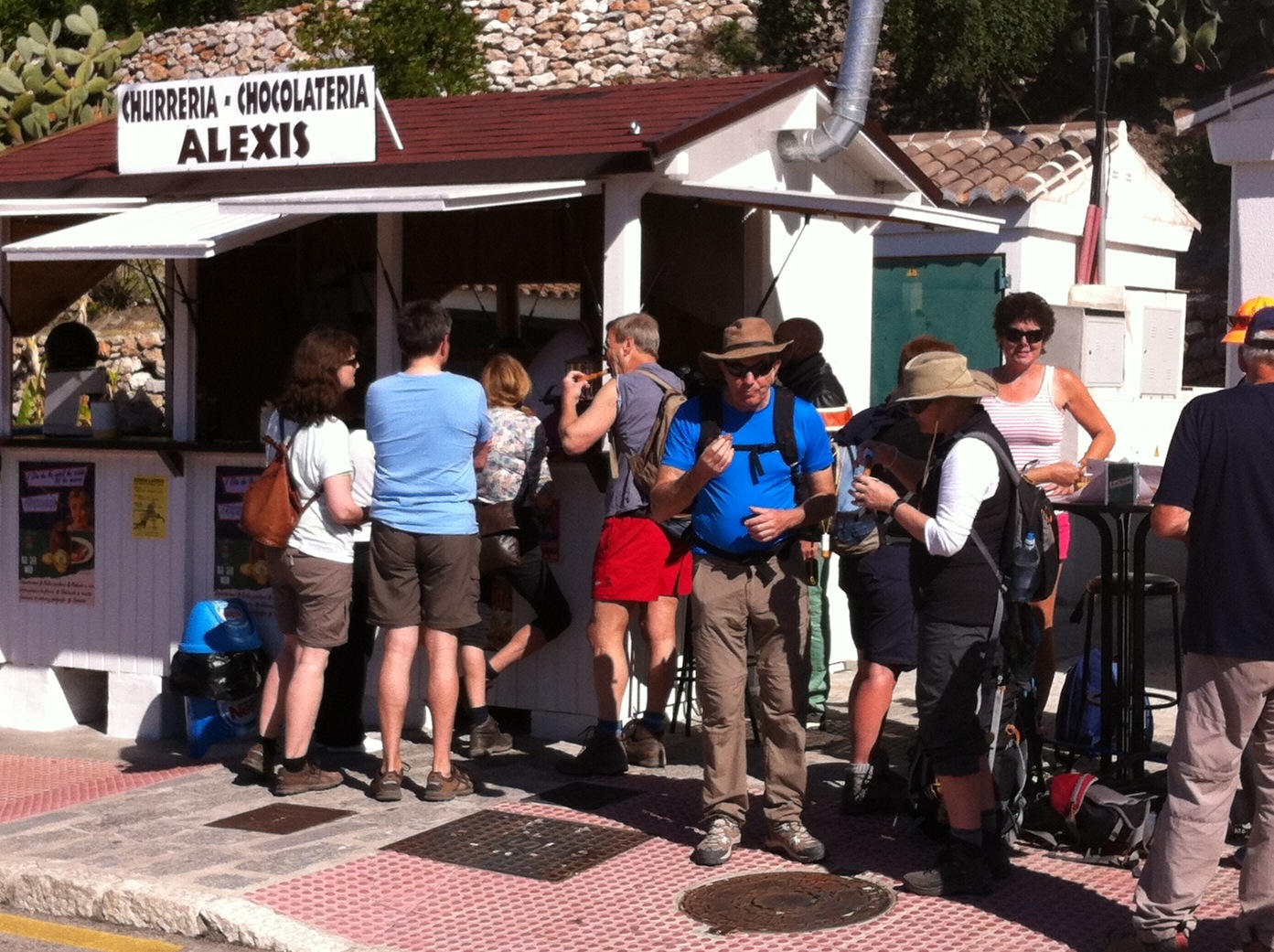 again, we strolled down to Frigiliana for the first of the farewell points. Hot chocolate and fresh churros from Alexis and that was where my Gran Ruta ended. A music event that night in Málaga followed by a flight to England the next day meant it made sense for me to jump on the bus to Nerja, nip up to Maro to pick up my bag from Salva and head straight home. Others dropped out at Frigiliana for different reasons, some took the shorter road route down to Nerja, while those determined to do every yard of the official route continued via the GR 242 to the final celebration and farewell. I salute them - they did well. again, we strolled down to Frigiliana for the first of the farewell points. Hot chocolate and fresh churros from Alexis and that was where my Gran Ruta ended. A music event that night in Málaga followed by a flight to England the next day meant it made sense for me to jump on the bus to Nerja, nip up to Maro to pick up my bag from Salva and head straight home. Others dropped out at Frigiliana for different reasons, some took the shorter road route down to Nerja, while those determined to do every yard of the official route continued via the GR 242 to the final celebration and farewell. I salute them - they did well.
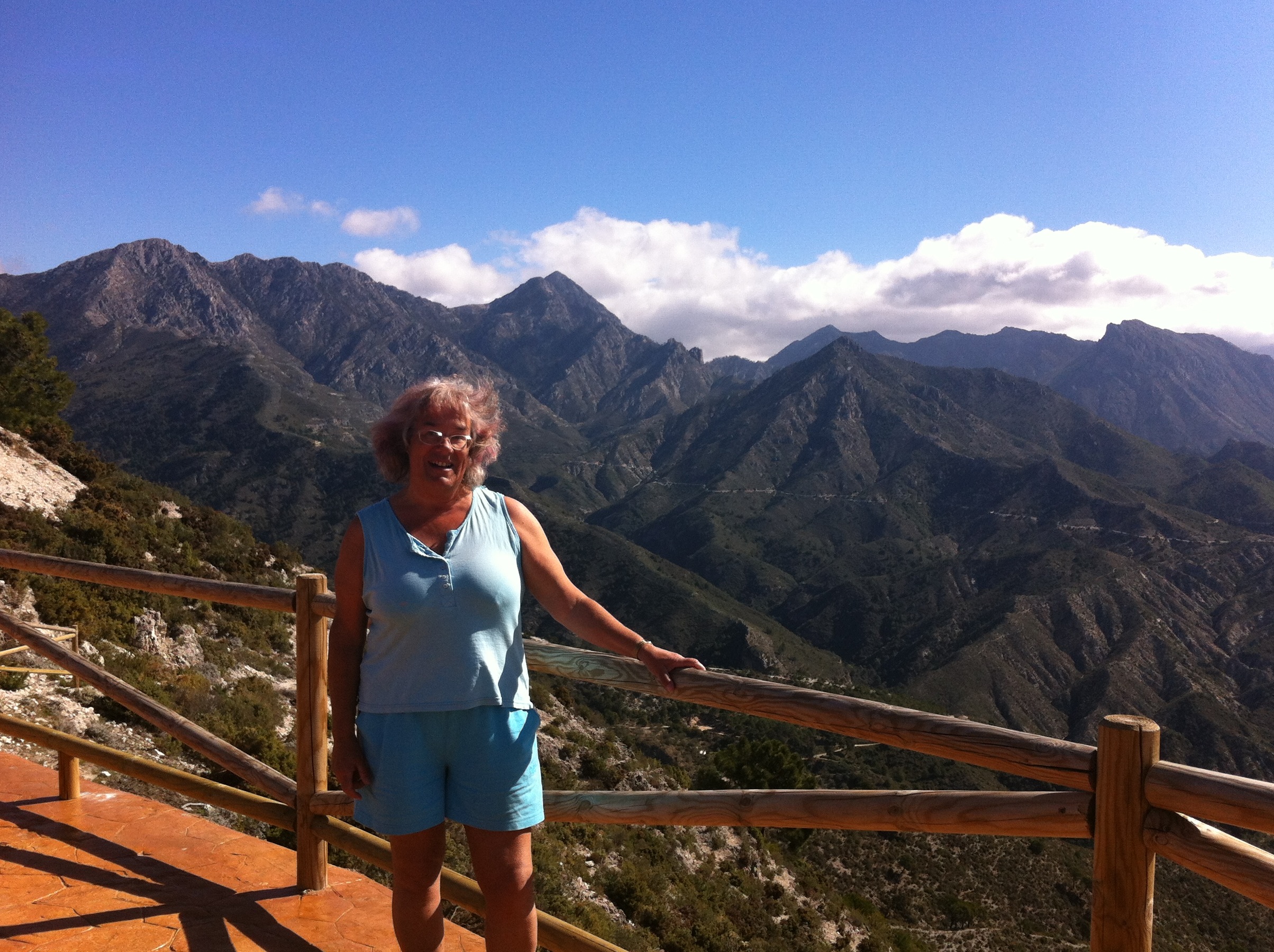 As in life, every walker fights their own battles, overcomes their own demons, and values their own achievements. Not every one of the 30 walked every yard. Blisters, sunburn, recent surgery, exhaustion, injuries and music concerts got in the way. But every one of the 30 can chalk up their own success, each one knows what they overcame and what they accomplished. The photos filling John's Facebook page tell a story of friendship, happiness, pain and triumph. Ah, it was a grand route. So it was. As in life, every walker fights their own battles, overcomes their own demons, and values their own achievements. Not every one of the 30 walked every yard. Blisters, sunburn, recent surgery, exhaustion, injuries and music concerts got in the way. But every one of the 30 can chalk up their own success, each one knows what they overcame and what they accomplished. The photos filling John's Facebook page tell a story of friendship, happiness, pain and triumph. Ah, it was a grand route. So it was.
© Tamara Essex 2014
Note 1 - John Keo is a professional walk-leader. His company runs a year-round series of day walks, usually out of 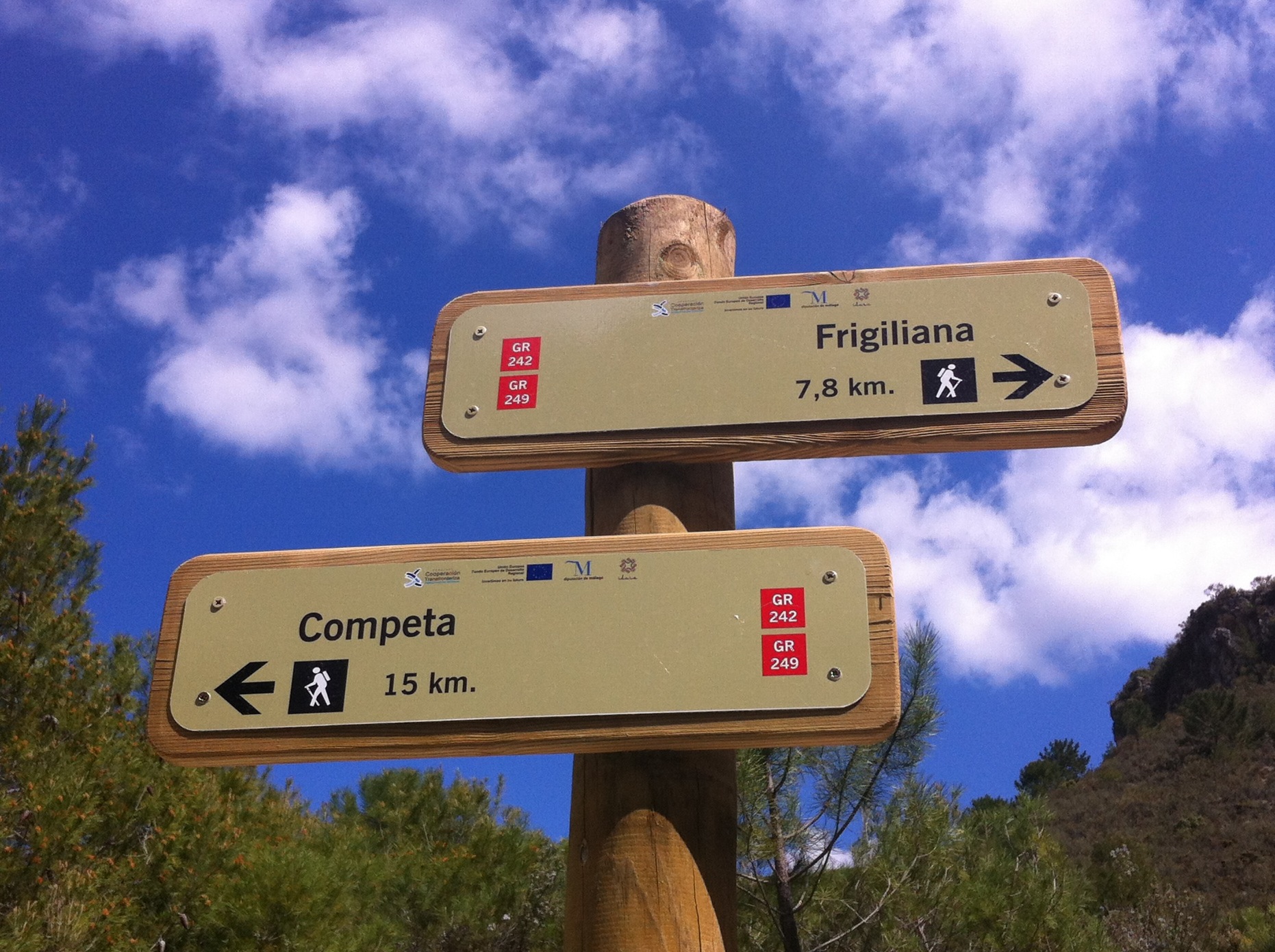 Nerja or Frigiliana. The walk to El Acebuchál runs most Wednesdays. Details of that and his other walks are on his website http://www.hikingwalkingspain.com/ or you can find John on his Facebook page https://www.facebook.com/JohnKeoghWalkingTours. "The Long Walk" was a one-off event covering 50 miles for John's 50th birthday, for a €50 donation to Cudeca, the local cancer charity. Along with sponsorship raised by individual walkers, at the last count John's birthday walk had contributed €2000 euros. So it has. Nerja or Frigiliana. The walk to El Acebuchál runs most Wednesdays. Details of that and his other walks are on his website http://www.hikingwalkingspain.com/ or you can find John on his Facebook page https://www.facebook.com/JohnKeoghWalkingTours. "The Long Walk" was a one-off event covering 50 miles for John's 50th birthday, for a €50 donation to Cudeca, the local cancer charity. Along with sponsorship raised by individual walkers, at the last count John's birthday walk had contributed €2000 euros. So it has.
Note 2 - Due to the length of this post, language points will return in the next blog post. So they will.
 0
Like
Published at 1:44 PM Comments (2)
0
Like
Published at 1:44 PM Comments (2)
Spam post or Abuse? Please let us know
|
|